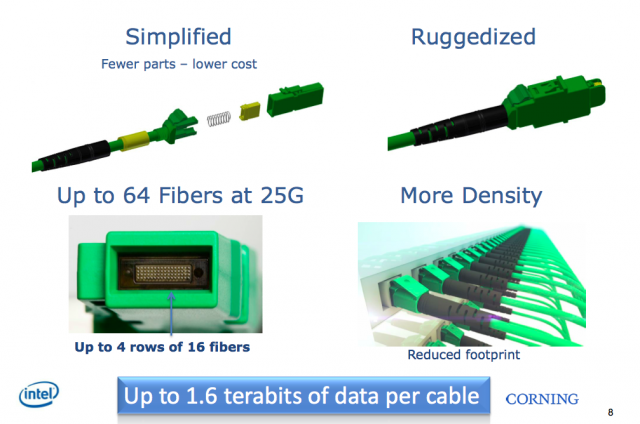
Intel and several of its partners said they will make 800Gbps cables available in the second half of this year, bringing big speed increases to supercomputers and data centers.
The new cables are based on Intel's Silicon Photonics technology that pushes 25Gbps across each fiber. Last year, Intel demonstrated speeds of 100Gbps in each direction, using eight fibers. A new connector that goes by the name "MXC" holds up to 64 fibers (32 for transmitting and 32 for receiving), enabling a jump to 800Gbps in one direction and 800Gbps in the other, or an aggregate of "1.6Tbps" as Intel prefers to call it. (In case you're wondering, MXC is not an acronym for anything.)
That's a huge increase over the 10Gbps cables commonly used to connect switches and other equipment in data centers today. The fiber technology also maintains its maximum speed over much greater distances than copper, sending 800Gbps at lengths up to 300 meters, Intel photonics technology lab director Mario Paniccia told Ars. Eventually, the industry could boost the per-line rate from 25Gbps to 50Gbps, doubling the overall throughput without adding fibers, he said.
Intel partnered with Corning to develop new fibers to support the Silicon Photonics transmission technology, which converts electrical signals into optical ones and vice versa. Intel also worked with US Conec on the project. Those three companies today announced their plan to sell MXC cables."MXC cable assemblies have been sampled by Corning to customers and will be in production in Q3 2014," an Intel presentation said. "US Conec announced that it will sell MXC connector parts to Corning and other connector companies."
US Conec established an MXC certification program to help other companies sell the cables. Tyco Electronics and Molex are the first besides Corning to announce that they will build and sell MXC cable assemblies.
Corning refused to say how much the cables and connectors will cost. Obviously, the 800Gbps ones will be the most expensive. Customers can order connectors with 8, 16, 32, or 64 fibers to fit their needs and budgets.
Typical designs max out at 12 or 24 fibers per connector, Corning's David Hessong, product line manager for embedded and optical systems, told Ars. The MXC design is higher-density and less sensitive to damage from dust and scratches than previous technology, he said.
Intel and Corning expect the first adopters to come from the supercomputing and cloud computing markets. The world's fastest supercomputers are composed of thousands of servers that work together to solve computational problems. Those systems would benefit from faster interconnects, Paniccia noted.
Cloud computing data centers are also likely early adopters. "They will be the first to adopt whatever speed you can give them," Hessong said.
Microsoft and the Facebook-led Open Compute Project are among the organizations already testing out the MXC-based cables.
Providing faster connections between top-of-rack switches and core switches, and connecting servers to extra storage or GPUs are among the expected use cases.
Longer-term, Intel wants Silicon Photonics inside racks. As we wrote last year, future server racks could use a "more efficient architecture that separates CPU, storage, power, and networking resources into individual components that can be swapped out as needed. Power and cooling would be shared across CPUs, rather than having separate power supplies for each server. Server, memory, network, and storage resources would all be disaggregated and shared across the rack."
As this approach pushes components further apart, faster interconnects would be needed. Bringing optical interconnects inside data center racks would be a big upgrade, but an expensive one. While Intel and Corning provided no hint as to how much the MXC cables will cost, Paniccia said the companies want to make the technology cost-effective so it can be "cheap enough to compete with copper."
In an announcement, Paniccia described some of the ways vendors are planning to use MXC and Silicon Photonics.
"Fujitsu recently demonstrated an expansion box that increases the storage capacity and adds CPU accelerators to its 1U server. In September, Intel demonstrated a new rack architecture called RSA that, when used with MXC cables and Intel Silicon Photonics, enables a totally new server architecture that increases performance and decreases cost. In the coming months, we expect to see more demonstrations and announcements about MXC and Intel Silicon Photonics."
reader comments
104